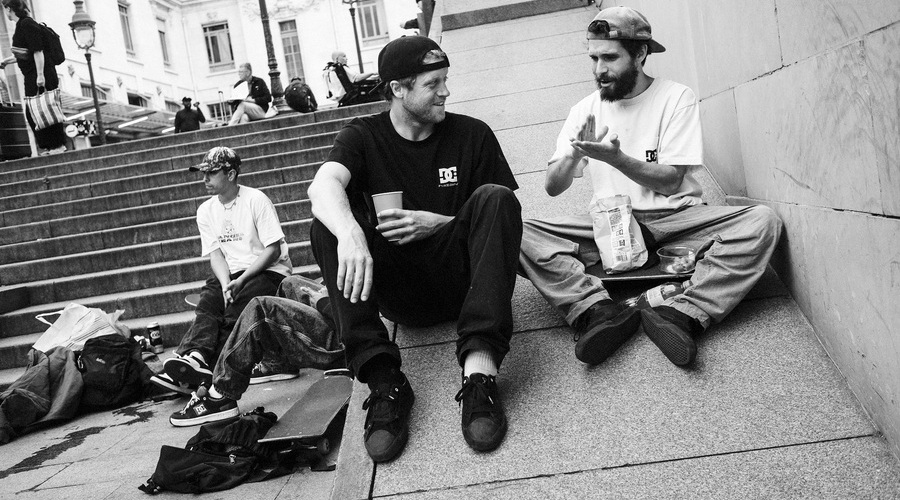The Storied History of Skatewear
August 18, 2023
Skateboarding, born in the streets of California in the 1940s and gaining widespread popularity in the 1970s, brought about its own unique fashion culture with skate shoes and skatewear. The evolution of these elements is a reflection of skateboarding’s rebellious spirit, counterculture influence, and the desire for functionality on and off the board.
Early Days and the Birth of Skate Shoes: In the early days of skateboarding, enthusiasts rode on homemade boards, often repurposing roller-skate wheels attached to planks of wood. However, the primitive equipment resulted in safety concerns and a need for specialized shoes that could provide better grip and protection. During this era, Vans emerged as a pioneer by releasing the “Authentic” shoe in 1966. With a vulcanized rubber sole and a diamond-patterned texture, the Vans Authentic provided superior grip, making it an instant hit among skateboarders.
The Skateboarding Boom in the 1970s: The 1970s saw a massive surge in skateboarding’s popularity, leading to the emergence of skate parks and a growing community. During this period, the Z-Boys, a group of influential skateboarders, further propelled the sport’s visibility. In response to the demands of the evolving sport, Vans introduced the “Era” model, featuring padded collars and reinforced toe caps for enhanced durability. This shoe design addressed the needs of skaters who required more protection and support during tricks and maneuvers.
Vans and the Birth of Skate Style: As skateboarding’s cultural impact expanded, so did its influence on fashion. Vans became synonymous with skate culture, and the checkerboard pattern on the “Slip-On” model, introduced in the late 1970s, became an iconic symbol of the skater aesthetic. The low-top silhouette of Vans shoes provided both flexibility and board feel, crucial for executing tricks. Skateboarders embraced these shoes not only for their practicality but also for their distinctive style.
Airwalk and the Evolution of Skate Shoes: While Vans dominated the skate shoe scene, the 1980s introduced a new contender: Airwalk. Airwalk’s “Prototype 600” introduced a high-top design, catering to the growing vert skateboarding trend. This shoe featured padded collars and tongues, offering more ankle support and protection during high-impact tricks. The emergence of Airwalk highlighted the evolving needs of skateboarders and the increasing diversity in shoe design.
The 1990s and Technical Innovation: The 1990s marked a period of technical innovation in skate shoes. Brands like Etnies, DC Shoes, and éS Footwear entered the market, introducing advanced cushioning systems and improved materials. These advancements aimed to enhance performance and comfort during the physically demanding activity of skateboarding. The bulky, padded designs of the late ’90s reflected the “big shoe” trend, offering both style and functionality.
Skatewear: A Fusion of Style and Function: As skateboarding culture matured, it brought about a distinct style of clothing known as skatewear. Skaters sought clothing that allowed for freedom of movement while reflecting their unique identity. Baggy jeans, oversized t-shirts, and hoodies became staples of skatewear. These clothing choices not only facilitated movement on the board but also expressed a sense of nonconformity and anti-establishment sentiment.
Influence of Hip-Hop and Street Culture: The late 1990s and early 2000s witnessed an intersection of skateboarding, hip-hop, and street culture. This fusion gave rise to brands like Supreme, which embraced the ethos of both skateboarding and urban lifestyle. Collaborations between skatewear brands and artists from various genres further blurred the lines between fashion, music, and skateboarding culture.
Modern Era and Technological Advancements: In recent years, skate shoe technology has evolved to unprecedented levels. Brands like Nike SB and Adidas Skateboarding incorporate innovative features such as advanced cushioning, impact protection, and breathable materials. These advancements not only enhance performance but also align with the growing emphasis on athleticism in skateboarding.
Sustainability and Ethical Considerations: As awareness of environmental issues grows, sustainable practices have entered the skatewear industry. Brands are increasingly incorporating eco-friendly materials and ethical manufacturing processes into their products. This shift reflects the evolving values of the skateboarding community.
Conclusion: A Cultural Phenomenon: The history of skate shoes and skatewear is a testament to the evolution of skateboarding as a cultural phenomenon. From humble beginnings to mainstream recognition, skate shoes and skatewear have evolved in response to the needs and desires of skateboarders. The dynamic interplay between functionality and style, combined with a rebellious spirit, has solidified skateboarding’s influence on fashion and lifestyle. As the skateboarding community continues to grow, so too will the innovation and creativity that shape the future of skate shoes and skatewear.
